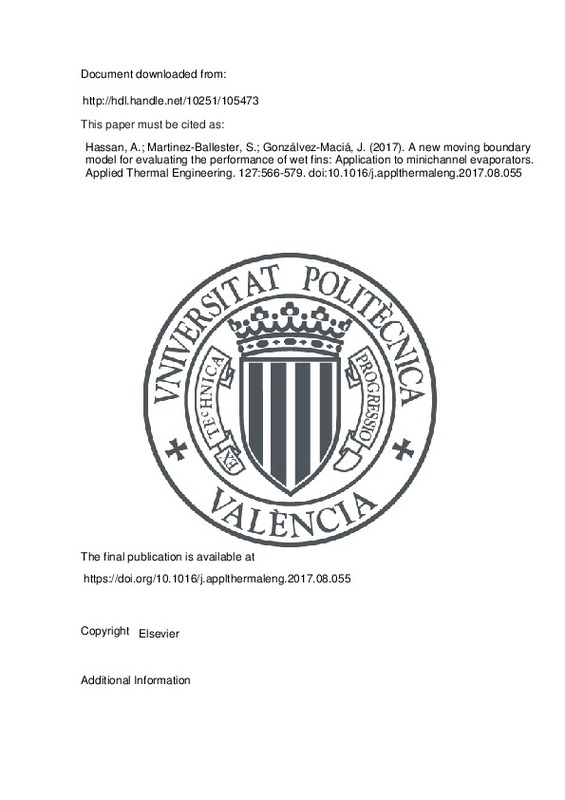JavaScript is disabled for your browser. Some features of this site may not work without it.
Buscar en RiuNet
Listar
Mi cuenta
Estadísticas
Ayuda RiuNet
Admin. UPV
A new moving boundary model for evaluating the performance of wet fins: Application to minichannel evaporators
Mostrar el registro sencillo del ítem
Ficheros en el ítem
| dc.contributor.author | Hassan, Abdelrahman-Hussein
|
es_ES |
| dc.contributor.author | Martinez-Ballester, Santiago
|
es_ES |
| dc.contributor.author | Gonzálvez-Maciá, José
|
es_ES |
| dc.date.accessioned | 2018-07-07T04:27:09Z | |
| dc.date.available | 2018-07-07T04:27:09Z | |
| dc.date.issued | 2017 | es_ES |
| dc.identifier.issn | 1359-4311 | es_ES |
| dc.identifier.uri | http://hdl.handle.net/10251/105473 | |
| dc.description.abstract | [EN] In this paper, firstly, an innovative numerical model (Fin1D-MB) for wet fins of a minichannel evaporator was developed and verified. The proposed model is based on fin theory in conjunction with the moving boundary (MB) technique between wet and dry portions along the fin height. Secondly, a comparative study between the Fin1D-MB model and a comprehensive two-dimensional model (Fin2D-W) was implemented under different dehumidifying conditions. The results showed a good agreement between the two models in predicting the fin temperature profile and dehumidifying condition. However, the Fin1D-MB model saved computational cost by up to 95%, compared to the Fin2D-W model. Nevertheless, the relative deviations in the air-side heat transfer rates should be taken into consideration, especially in the partially wet fin region. The main source of these deviations is the assumption of uniform air temperature and humidity ratio along the fin height used by the Fin1D-MB model. | es_ES |
| dc.description.sponsorship | The authors would like to gratefully acknowledge the financial support from the Spanish Ministry of Economy and Finance to project number DPI2011-26771-C02-01. The proofreading of this paper was funded by the Centro de Lenguas, Universitat Politecnica de Valencia. | en_EN |
| dc.language | Inglés | es_ES |
| dc.publisher | Elsevier | es_ES |
| dc.relation.ispartof | Applied Thermal Engineering | es_ES |
| dc.rights | Reserva de todos los derechos | es_ES |
| dc.subject | Wet fins | es_ES |
| dc.subject | Numerical modeling | es_ES |
| dc.subject | Minichannel evaporator | es_ES |
| dc.subject | Air-side analysis | es_ES |
| dc.subject | Heat and mass transfer | es_ES |
| dc.subject.classification | MAQUINAS Y MOTORES TERMICOS | es_ES |
| dc.title | A new moving boundary model for evaluating the performance of wet fins: Application to minichannel evaporators | es_ES |
| dc.type | Artículo | es_ES |
| dc.identifier.doi | 10.1016/j.applthermaleng.2017.08.055 | es_ES |
| dc.relation.projectID | info:eu-repo/grantAgreement/MICINN//DPI2011-26771-C02-01/ES/ESTUDIO DE EVAPORADORES Y CONDENSADORES BASADOS EN TECNOLOGIA DE MINICANALES PARA SU APLICACION EN EQUIPOS DE AIRE ACONDICIONADO, REFRIGERACION Y BOMBA DE CALOR ESTACIONARIOS/ | es_ES |
| dc.rights.accessRights | Abierto | es_ES |
| dc.contributor.affiliation | Universitat Politècnica de València. Departamento de Termodinámica Aplicada - Departament de Termodinàmica Aplicada | es_ES |
| dc.description.bibliographicCitation | Hassan, A.; Martinez-Ballester, S.; Gonzálvez-Maciá, J. (2017). A new moving boundary model for evaluating the performance of wet fins: Application to minichannel evaporators. Applied Thermal Engineering. 127:566-579. https://doi.org/10.1016/j.applthermaleng.2017.08.055 | es_ES |
| dc.description.accrualMethod | S | es_ES |
| dc.relation.publisherversion | https://doi.org/10.1016/j.applthermaleng.2017.08.055 | es_ES |
| dc.description.upvformatpinicio | 566 | es_ES |
| dc.description.upvformatpfin | 579 | es_ES |
| dc.type.version | info:eu-repo/semantics/publishedVersion | es_ES |
| dc.description.volume | 127 | es_ES |
| dc.relation.pasarela | S\341880 | es_ES |
| dc.contributor.funder | Ministerio de Ciencia e Innovación | es_ES |







![[Cerrado]](/themes/UPV/images/candado.png)

